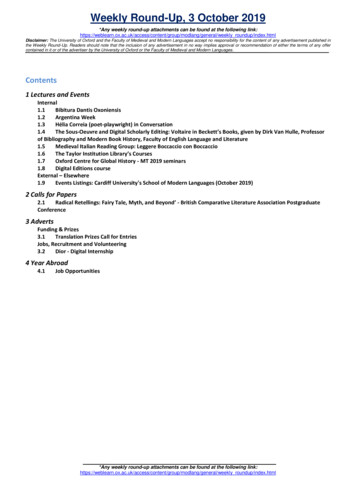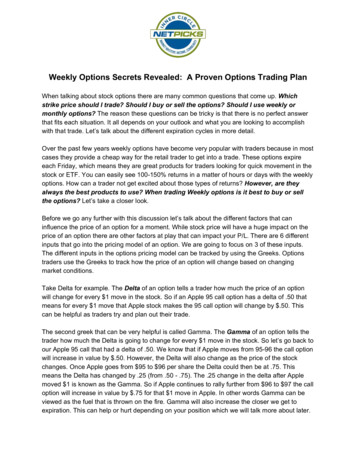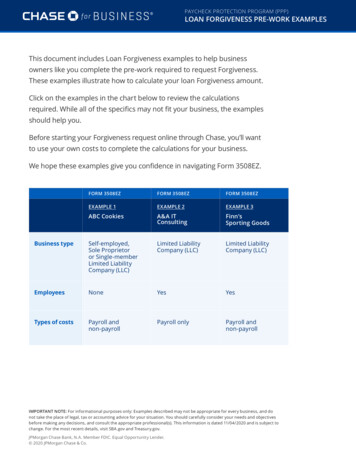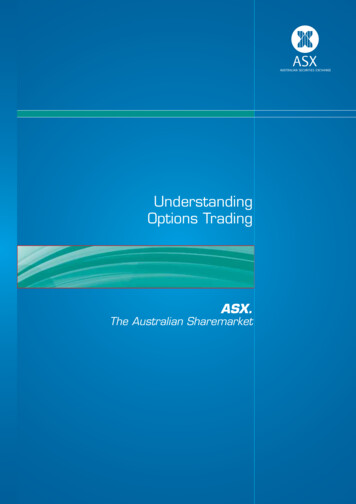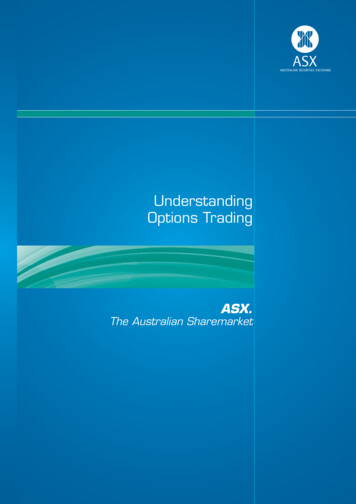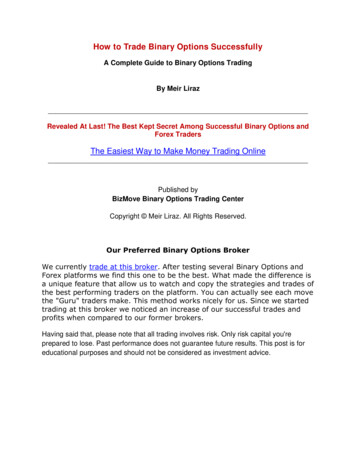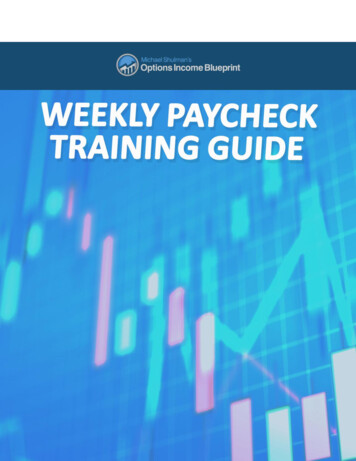
Transcription
ide
Michael ShulmanOptions Income BlueprintWelcome to my Weekly Paycheck Training Guide.This companion guide is a support document for my“Weekly Paycheck” training program geared toteach you how to trade weekly options specificallysell weekly “put options” to generate an “extra payday” every week.I developed my “weekly options selling strategy”from my personal experience a desire to generateextra cash income every month and every week inmy own investment account.In this training program, the focus is on creatingvery high returns on your capital in the form of consistent income -- incomeyou spend or put back into your account. It is not about extracting themaximum amount of profit out of every position - that is a recipe for creatinglosses.You’re going to learn about the “power” of weekly options how sellingweekly put options on stocks and ETFs can help you create a more consistent,predictable, repeatable source of generating weekly cash.I’m going to take you through the complete picture of selecting a weeklyoption to sell, when during the week to sell the option, how to execute thetrade, how to manage the trade and finally how to close the trade with thatextra cash in your account.I’m also going to walk you through step-by-step how to execute the trade.We’ll do a live trade together so that you can see how simple and efficientselling weekly options can be.2Weekly Paycheck Training Guide
I will introduce you to a special strategy that allows you to “Roll and Recover”if and when an option trade goes against you.Of course knowing how to work with your online broker to sell weeklyoptions is key to the process the ins and outs of everything from readingyour broker option screen correctly to how to track and record your weeklyincome position will be reviewed so that you will understand how to workwith your broker and read the screens to successfully manage the trade.And finally, I’ll reveal my own personal success strategy of selling weeklyoptions for extra income every Friday it’s a simple way for you to constructyour own portfolio and determine how much “extra cash” you want to makeevery week.This is the first step in wresting control of your portfolio from the market andputting in place an income generation strategy that could yield far more thanyou are earning now.Let’s get started!Selling Weekly Options vs. BuyingWhen you sell an option you are flipping or transferring the risk inherent inany option to the buyer and you collect the cash. It is yours instantly.More than eighty percent of all options expire worthless, more so with weeklyoptions, putting the seller is in the driver’s seat. Selling does not have the thrillof hitting a home run when you “buy an option” that goes up quickly – butthere are few if any double plays or disasters when you sell them.Monthly options are the most commonly trade option contracts. They expireat the close of the market on the third Friday of each month.Weekly options, however, are short-term trading contracts. They areintroduced on Thursday and they expire 8 days later on the following Fridayafter the market close.If you are like me and sell regular monthly options to generate premium, thenyou’ll love weekly options because we get 52 paydays every year.Weekly Paycheck Training Guide 3
The Advantages of Selling Weekly OptionsThere are a number of advantages to selling weekly options. The primaryadvantages are risk management, flexibility, and the ability to generateconsistent income.First, risk management: The key to income investing - any investing actually- is to preserve capital, to live and fight another day. The big advantageweekly’s have over monthly options is what we love about selling monthlyoptions the time decay in an option contract that works on behalf of theseller.Flexibility:1. As you can imagine, with a contract being open only 8 days, the timedecay on a weekly option is ferocious and plays into the option seller’shand. This gives you the ability to capitalize on short-term plays like anews event, earnings announcement or sudden price movement in astock.2. Flexibility - your capital is not tied up in shares that may move thewrong way, shares that need to be managed through up and downmarkets and create uncertainty about your income next week or nextmonth.3. You can also turn this around – if you are convinced a company willsurprise the Street during earnings announcement, you can sell a putthe day before and when the stock rises get a large return in just 24hours with minimal risk.Consistency: The open interest and volume of contracts traded on weeklyoptions are large enough to produce reasonable bid-ask spreads, however, theopen interest and volume are usually not as high as monthly optionsexpirations.Perhaps the best advantage of selling weekly options is consistency. Half apercent gain, a typical gain in weekly trading - may be boring to many traders.4Weekly Paycheck Training Guide
But do this fifty times a year and the number is now twenty five percent peryear. Not so boring. Selling weekly options can create consistent income -- Noother investment tool can do this for you with such a low level of capital risk.Less Commissions: The typical weekly position expires worthless and thatmeans you pay only commission on the front end. And if you do buy back a putto close a position and that put costs less than a nickel, many online brokersnow offer commission free trades for the purchases of puts costing a nickel orless.Capital Preservation: A strategy of selling weeklies is by far the best choicewhen capital preservation is priority number one - due to the limited timeexposure to the market or other outside events.Here is How Time Decay Works in Favor of the Option SellerWhy do weekly options work so well for option sellers?For example, earlier this month we sold a weekly option on biopharmaceuticalcompany Questcor, ticker symbol QCOR. We sold the November, Week One 55puts for .75 each and collected 75 per contract.Two days later I sent an alert to my members recommending that they let theQCOR November, Week One 55 Puts expire worthless on Friday. That meanswe kept the entire 75 per contract sold or 450 if you would’ve sold 5contracts. Sell Questcor (QCOR) November, Week One 55 Puts We collected 75 per contract in our account 2 days later Our QCOR November, Week One 55 Puts expiredworthlessWe kept 75 per contract sold or 450 if you sold 5 contracts!What happened?Weekly Paycheck Training Guide 5
The Value of Time DecayAs you might guess, time decay – the loss in value ofthe option over time even if the stock does not move –is ferocious on a weekly option on a stock like Questcor.And that’s a very good thing for the seller of optionsbecause most weeklies expire worthless.And you get to keep all the cash. We did!Do this every week and you can see how this can add up to a regular “extrapay day” every Friday.Risks in Selling Weekly OptionsThere are some downsides to selling weekly options that I want you to beaware of.Because of their short time frame and rapid time decay, it can be more difficultfor you to recover or repair a trade that has moved against you after you’vesold a weekly option. But don’t worry about that now later in this program Iwill teach you a simple way to recover and profit from a weekly option tradethat may go against you.Selling weekly options is a great tool to keep in your trading toolbox when itcomes to selling premium and generating income.So now you understand what weekly options are and why selling them worksto your advantage.Lets Learn How to Sell Weekly Put OptionsMy income-oriented strategy is flexible and works in any market and is allabout selling weekly option puts.6Weekly Paycheck Training Guide
Available Weekly OptionsWeekly options are not hard to find – more than 450 stocks and ETFs haveweekly options. Virtually all broker screens show weekly options inside theiroption chains. Some public sites do a poor and confusing job presentingweekly options; I strongly recommend you stick with your broker screens.There are some large, mega cap sticks, such as Apple and Google and Bank ofAmerica, where you can find a weekly option listed weeks in advance but thisis not the norm. More typical is finding options listed one week in advance.The universe of weekly options grows, literally, every week.When I began selling weekly options the universe wasless than fifty. These weekly options are available forforty weeks of the year. The CBOE – the Chicago BoardOptions Exchange – updates the list every week andyou can download it in spreadsheet form. Check out thelist at the CBOE link eeklys.aspxSelling a Weekly Option PutA put is a contract entitling the buyer of the contract to sell you shares at afixed price on or before a specific date in the future. Each option contractcontrols 100 shares of the stock.Weekly Paycheck Training Guide 7
You will hear the terms puts, cash secured puts and naked puts.That said, this training program is all about selling ‘CASH SECUREDPUTS”, not naked puts.Here is the definition a Cash Secured Put according to the CBOE’s OptionInstitute:Cash Secured Put: An investor who employs a cash-secured put writes a put contract, andat the same time deposits in his brokerage account the full cash amount for a possiblepurchase of underlying shares. The purpose of depositing this cash is to ensure that it'savailable should the investor be assigned on the short put position and be obligated topurchase shares at the put's strike price. While the cash is on deposit it may generally beinvested in short-term, interest-bearing instruments.The term “cash” in cash secured puts means must have collateral cash topurchase shares if they are assigned (or put) to you. You are not buying anoption and you are not spending capital, but you have to have or leave enoughcapital it in your account to support the position.For example, if you sell a weekly put option on General Motors (GM) at theNovember, Week Four 45 strike, you will need to have 4,500 in yourtrading account for every contract you sell.Why?Because in selling an option contract, the buyer of your option has the right toassign the stock to you the seller if and when the stock price is falls belowthe strike price. The buyer of that option doesn’t have to assign, but he has the“right” to assign or “put” the stock to you.In our example above, if you sell that GM November, Week Four 45 Strikeon Monday and the price of GM stock declines below 45 to 44.50 or lowerby Wednesday, you could be assigned the GM stock at 45 per share or 4,500for one option contract sold.If you have a large enough trading account in dollars and qualify for margin,you can use margin instead of cash to support a put. For the purpose of thistraining program, we will focus on maintaining cash in your account tosupport the sale of a put.8Weekly Paycheck Training Guide
We will spend more time on this importance difference between spendingcapital and using it to support a put position later on.Key to the strategy of selling puts is to remember: you are not buying anoption contract; you are not locked into buying shares.Your cash or margin is sitting in your account supporting a put position. Thisis very different from owning shares.Best Time to Sell Weekly OptionsWeekly options open on Thursdays and last for 8 days ending on thefollowing Friday after the market closes.You can sell weekly options on any of those 7 market days, including the lastday of expiration Friday.Weekly options are listed differently then longer term options on your brokeroption chain.In this screen shot, you can see the next weekly option contract for GM in red.Here is how you interpret that line:NOV 4(the 4th week or Friday of NovemberWeekly Paycheck Training Guide 9
(7)100(Weekly’s)(Seven days until expiration)(Number of shares in each contract)(Also, another indication it is a weekly option contract)Also, some weekly option contracts are listed and open in advance of 7 days, anew trend that has started for some of the more popular and widely tradedstocks.Which day you sell a weekly option depends on a number of factors includingthe recent stock price movement, external factors like earnings or news, andhow much premium is available on the day you want to open the position.I prefer to sell weekly options on Wednesday before expiration. That leavesaround 2 ½ days for the option to remain open and less of a chance that anybad news or market sell-off may negatively impact the position.Thursday (7 Days Out): Better for more stable or low volatility stocksMonday (5 Days Out): Ok for momentum stocks in a bull runWednesday (2 Days Out): I like Wednesdays because of the short-timeframe for many stocks that you would sell weekly options.10Weekly Paycheck Training Guide
Construct a Weekly Put TradeOk, now we’ve selected one or more stocks or ETFs to sell weekly puts and it’stime to check and see if they will make good put selling positions.There a few factors that we will use to determine if our stock or ETF choiceshave the right type of option contracts we can sell.Volume: One of the first things to look at when selecting the right optionvolume. Option contract volume is important because you don’t want to tryand sell a put option where there are few and far potential buyers out there.When we look at volume, there are several terms we use that you shouldbecome familiar with:Open Interest (Open Contracts): Open interest refers to the number of putsthat have been written, on that specific position.Daily Volume: Daily volume is the number of contracts for that specific putthat have traded that day.VOLUME AND OPEN INTERESTWeekly Paycheck Training Guide 11
Bid/Ask Spread: The “Bid” is what someone is willing to pay for an optionput you will sell. The “Ask” is the current asking price by other sellers. Thespread, typically something you calculate on your own, is the differencebetween the two.In constructing a weekly option position, consider these volume factors:1. Current Open Contract Volume: This is the Volume of Open Put OptionContracts within 5 or 6 strikes of the price of the stock. If I see 100 ormore contracts are open (see the screen above) on the strike I want tosell, then it passes my volume test. Next, I check the Bid/Ask spread atthe strike(s) I’m looking to sell.2. Bid/Ask Spread: The Bid is what someone is willing to buy the optionfrom you since you are the seller. I like the difference between the “Bid”and the “Ask” to usually be .01 to .05. My maximum spread in theprice would be .10.You may find a interesting stock or ETF with pricing momentum that youthink would make a good choice to sell weekly puts but a quick scan of theoption chain may show there is not enough volume and/or the spreadbetween the bid and the ask is too far apart.12Weekly Paycheck Training Guide
Time to move and look at the next stock for minimum option volume.Using Volatility to Construct a TradeYou’ve found a stock or ETF with sufficient option volume and a small bid/askspread, now it’s time to check on volatility within the option you want to sell.Volatility is the friend of the “option seller” and most online broker screenswill calculate and provide the Implied Volatility in the option chain for eachspecific strike price.When it comes to selling weekly puts, ideally look for an option strike pricewith Implied Volatility of around 25. Anything 25 to 34 is ok. 50 or moreand it gets too hairy and too volatile to work when you’re selling a weeklyoption.IMPLIED VOLATILITYPremium: The Cash You Collect From Selling the Weekly Put OptionWhen it comes to selling options, we try to look for rich premiums the rangecould be anywhere from .20 per share or 20 per contract sold and someWeekly Paycheck Training Guide 13
weekly’s can generate premium .50, 1.00 or even more. Stocks like Apple,Google and Amazon can have weekly option premium that runs anywherefrom 2 to 6.Because of the shorter time period to expiration, weekly options tend to carryless premium, depending on how far out of the money you go and how manydays you will be in the position.When we sell weekly options on stocks like Ford (F), Bank of America (BAC)or other stocks under 30, the premiums are going to run less than .30 andmaybe even under .20, or less depending on what day of the week you trade.If we sell Ford weekly puts on a Monday with 5 days to go, depending on thestrike price, we might get anywhere from .25 to .30. Wait until Wednesday(a day I like to sell weekly options), and you may only get .15 or .20.The good news is that you are only in the trade for 2 ½ days with a betterchance of having the put expire worthless. However, depending on whichonline broker you use, option-trading commissions could eat up half of yourcapital.PREMIUM AND THE STRIKE14Weekly Paycheck Training Guide
However, when we sell a weekly put option on a stock like Western Digital(WDC) (around 85) or even General Motors (GM) (around 45), we couldcollect premiums of anywhere from .25, .50, .65 or more for selling aposition for just 2 ½ days. Even after option trading commissions of 4.95 to 6.95, you are still going to collect sufficient cash from one of these positions.Your only risk is tying up a little more capital.The Strike PriceThe strike (or exercise) price of an option is the specified price per share atwhich underlying stock will change hands after a call or put is exercised by itsowner.In the chart below, the strike prices are listed to the far left of the screen.When you are “buying” a put option, the STRIKE PRICE is said to be “in-themoney” if the price of the security is below the strike price.BUT, when you “SELL” a put option, a put option STRIKE is “IN-THEMONEY” if the price of the security is above the strike price.Weekly Paycheck Training Guide 15
When you “SELL” a weekly put option, we usually look to select a “STRIKEPRICE” that is “OUT-OF-THE-MONEY” where the strike price is less than theprice of the underlying security or index.STRIKE PRICEEntering Your Weekly Option PositionNow we’re ready to enter our trade. We have the stock and the strike pricewe want to sell.Select the Strike Price from the Option Chain and then you will be presentedwith different “prompts” to execute your trade.ACTION: Sell To OpenWhen you look at the action to take you will see the following on your brokerscreen:Buy to OpenBuy to CloseSell to Open16Weekly Paycheck Training Guide
Sell to CloseThe most important action to follow when we are selling weekly puts, is the“Action” or the order should always be “Sell to Open” a contract.CONTRACTS: Number of ContractsHow many contracts you are going to sell (100 shares per contract).ORDER TYPE: Limit or MarketJust like when you buy a stock, a market order will fill at the price in themarket at the time of your trade. A limit order, allows you to specify thepremium price you will accept for selling your weekly option contract.Monitoring and Managing Your Weekly Option PositionRemember, our goal selling weekly put options is to place the trade with theexpectation that the option contract will expire worthless and we keep theentire amount of cash premium we collected at Friday after the close.And that ties into the benefit of selling weekly put options. With weeklyoptions, there is a limited amount of time for your trade to be open andexposed to outside events or bad markets, and a better chance that theoptions contract will expire worthless (and you keep all of the premium) onFriday.Compared to a monthly option, there is far less time (only 1 to 7 days) towatch and monitor your weekly option position, which reduces risk anddoesn’t take all of your time to track your position(s).Weekly Paycheck Training Guide 17
Monitoring Your PositionThe stock market is unpredictable and full of surprises. You should not sell aweekly option and totally forget about it. You will have to do monitor yourtrade position for however short of duration you are in the trade.Here are a few of key indicators you should remember when it comes tomonitoring the weekly put option positions you’ve sold:1. An Overall Market Sell-Off in One Day: If the broad market is sellingoff anytime during a given trading day, then you will want to check in tosee what the sell-off is doing to your position and your stock price. Ifthe stock price is down but still well above your option strike price,you’re probably ok for the remainder of that day.2. Market Sells Off for Multiple Days: Market sell-offs over multipledays in a week can impact your position, even if you’ve sold deep out ofthe money puts. If you get into two or more days of broad marketselling, then you may have to take action with your position, and you’llcertainly need to monitor it more closely.3. Sector Movement: If the general market is flat or up, but the sector ofthe stock you are selling the weekly put is down, then you will need tocheck to see how your position is doing once or twice during the day.4. Stock Sell-Off: If your stock is selling off independent of the market orthe sector, then you may need to check the headlines around the stockto see what is causing this. If it’s down slightly, it may be normal sellingand you can ignore it.5. News on Your Sector or Stock: Again, many times stocks rise and fallbased on rumors, news and stories. If bad news comes out on yourstock or sector, then you may have to check in to see if it’s workingagainst your trade. If your stock is down by 2% or more, then mostlikely some negative news around your stock is affecting the price.6. Earnings or Upgrade/Downgrades: If the stock you are selling putsagainst is announcing earnings that week, it could and probably willimpact the price of the stock and your weekly put position. I usuallydon’t recommend selling weekly puts during the week of an earningsannouncement for the company.General Rules of Thumb for Monitoring Your Weekly Put Position:18Weekly Paycheck Training Guide
If you sell a weekly put option 7 to 8 days out, you should check in eachmarket day to see what is happening to your position.If you sell a weekly put 2 days out on Wednesday (one of my favorite days tosell puts), then Thursday will be a key day to watch your position for anysignificant price movement.Friday Monitoring: Many Friday’s tend to be slower trading days and themarket may not be as volatile as earlier in the week. If the market opens flatto slightly up or down, and your stock is trading well above your put optionprice, then your position will most likely expire worthless.Friday Caveats: On rare occasions, bad news or rumors can hit a stock, asector or even the broad market on Friday anytime. It’s not a bad habit tocheck your position at noon on Friday.Automated Trade ManagementToday with computing power and high-speed Internet connections, there area number of ways you can automate the management of your weekly optiontrade positions. Almost all online brokers who offer stock and options tradingare able to accommodate automated trade management.For many experienced stock and option traders, the most efficient way is toautomate their trade and place a conditional order when they are executingtheir weekly option trade:Conditional Orders: Conditional orders let you combine two or threeindividual orders that will, if filled, either cancel or trigger additional orders.An OTA Conditional Order (one triggers another): Here, you submit anorder to sell a weekly put option and if that order is filled, it will automaticallysubmit another order—a “Buy Order” or “Buy back that option” at a predetermined price. That order will be in place for the duration of the trade or“good until cancelled.”Example: If you place an order to sell XYZ Stock November, Week Four 30 putoption for .35 or 35 a contract, at the same time you place an “OTA” order toWeekly Paycheck Training Guide 19
“Buy Back Your” XYZ Stock November, Week Four 30 put option when itreaches .20 or 20 per contract.If XYZ stock at the time of the order was trading at 31 but sold off closer toexpiration and was trading closer to 30, your OTA order would trigger a“buy” when XYZ November, Week Four 30 option reached .20 or 20 percontract. The “buy back” trade is automatically executed for you and youspend 20 to buy the option back, but you keep 15 per contract (less yourtrading commissions).If you set your trade with the expectation of the position expiring worthlesson Friday or you would rather make the decision to “buy back” one of yourweekly option positions, instead of letting it automatically trade, there areother alternative ways to do this with your online broker.Setting Trade Alerts: One of the easiest ways to monitor your weekly putposition is to use your online broker’s alert system. These days, almost everyonline broker who offers options trading has an alert system that can sendyou an alert when a stock or option trade reaches a certain price level.These alerts can be sent via email, text or automatically to your smart phoneor tablet application to alert you of a stock price movement.At the same time you execute your trade you should set an alert to be sent toyou. The alert should be triggered to send when the stock price of the optionyou are selling is within 2 to 4% being “in the money” of the strike price.When you receive the alert, you can then make a decision about how andwhen you will take action to manage your position.Managing Your TradeAs we discussed above, selling weekly put options are a relatively “lowmaintenance” process.Let me show you.Earlier this year, I recommended to my Options Income Blueprint subscribersto open a position on Starbucks, ticker symbol SBUX. We sold the Starbucks20Weekly Paycheck Training Guide
(SBUX) November Week Two 79 puts (weekly option) for 1.10 or 110 percontract sold. It would’ve taken one of my members five minutes or less toenter the trade and watch it fill. Sell Starbucks (SBUX) November Week Two 79 Puts Collect 106 per contract sold Less then 5 minutes to enter this tradeThe stock price on Starbucks began to move the next day ahead of theirearnings announcement. I sent out an alert recommending that my membersclose the position, spending 21 to buy the contract back and we ended upwith 89 per contract gain in less than 24 hours.That took all of about ten minutes of time to sell and then buy back theoption! Starbucks price surge before earningsBuy back the contract for 21 per shareKeep 89 per contract of profit in less than 24 hoursTook all of about 10 minutes timeWeekly Paycheck Training Guide 21
With some modest planning, you should only need to spend about 30 minutesper week monitoring and managing your weekly option positions.Managing a Position That Goes Against YouThere will be times when weekly option put positions move against you andyou will have several choices to make. I covered a number of scenarios abovein monitoring your position and now it’s time help you with managing aposition that goes against you.If the stock you have written weekly put options is selling off and the stockprice is going to finish expiration Friday below your strike price, two thingscould happen to your position.1. If the price of the stock finishes under but close to your position strikeprice, your option position may still expire worthless and you keep theentire premium. The buyer of your option contracts has decided not to“exercise” his right to assign or “put” the shares to you.Or 2. The buyer of your weekly option could decide to exercise hiscontractual right and assign the shares of stock that your capital ismaintaining.With the second scenario, you have several choices of action to take.1. Close the position early with a smaller profit or even at break-even. Ifyou are monitoring your open weekly position, and see that the stock isselling off, you can decide to close the position early, at less profit or atjust break-even.2. You could decide to accept the assignment of stock and you will receivea notice from your broker letting you know that the buyer of youroption contract has decided to assign you the shares. The cost of thoseshares will be paid for by the capital you have maintained in youraccount. You will now own at least 100 shares of the stock (or more ifyou sold more contracts).22Weekly Paycheck Training Guide
NOTE: Being assigned the shares is not necessarily a bad outcome. You maylike the stock you’ve sold a weekly option contract and you don’t mind owningthe shares at the strike price you sold the original option. In some cases,experienced traders will use a put selling strategy to “acquire stock”, ratherthan outright buying the stock. If they can set the price they will acquire thestock through a target strike price on the put, they don’t mind if they getassigned the stock.However, there is a third outcome for your trade and it’s a relatively simplestrategy that allows you, the option seller to avoid taking a loss or beingassigned the stock.It’s “Roll and Recovery” and it’s worth the time for every investor to learnabout how to “roll and recover” when you are new to selling options.Rolling and RecoveryRolling your weekly option position is a critical tactic to learn and employ tohelp you avoid taking a loss or being put a stock.To avoid assignment on a short put, we roll the position to a new strike pricefurther out.When you roll a position, you are taking a net loss on the first (or front week)put you sold and generating more cash than that loss through the sale of asecond position (back week).Here is how you roll a weekly put position:For example, let’s say you’ve sold a 7-day cash-secured weekly put on stockXYZ with a strike price of 39. And let’s say you received 0.35 for the putwhen the stock was trading at 40. Now, close to expiration, the stock hasdropped and it’s trading at 38.50.The only way to a
Options Income Blueprint Welcome to my Weekly Paycheck Training Guide. This companion guide is a support document for my Weekly Paycheck training program geared to teach you how to trade we
